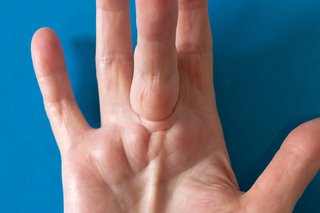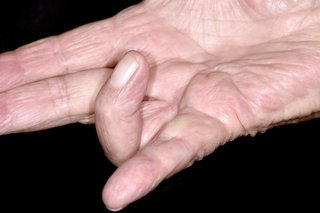Dupuytren's contracture
Dupuytren's contracture is when 1 or more fingers bend in towards your palm. There's no cure, but your fingers can be straightened if it's severe.
Check if you have Dupuytren's contracture
Dupuytren's contracture mainly affects the ring and little fingers. You can have it in both hands at the same time.
It tends to get slowly worse over many months or years. Treatment can't usually help in the early stages.


If you're not sure it's Dupuytren's contracture
See a GP if 1 or more of your fingers are bent and:
- you can't put your hand down flat
- you're having difficulty with daily activities
You'll probably be offered treatment. Your GP may refer you to a surgeon to discuss your options.
You can ask to be referred to a hospital of your choice.
Treatments for Dupuytren's contracture
Speak to a surgeon about the options, what the benefits and risks are, and what to expect afterwards.
Your finger may not be completely straight after treatment, and might not be as strong and flexible as it used to be.
The contracture could also come back after a few years.
There are 3 main types of treatment.
Surgery to straighten the fingers
Fasciectomy
A cut is made along your palm and finger so the surgeon can straighten it.
- general anaesthetic (you're asleep) or local anaesthetic (your hand is numbed)
- you can leave hospital the same day
- recovery time: 4 to 12 weeks
- lowest risk of contracture coming back
- risks include bleeding, numbness and infection
Injections of medicine into the hand
Collagenase clostridium histolyticum (Xiapex)
Medicine is injected into your hand to loosen your finger. The surgeon then straightens it a few days later.
- local anaesthetic (your hand is numbed) for the straightening part
- you can leave hospital the same day
- recovery time: up to 2 weeks
- contracture more likely to come back than with surgery
- risks include an allergic reaction, numbness and infection
Using a needle to straighten the fingers
Needle fasciotomy
A needle is inserted into several places along your palm and finger to loosen and straighten it.
- local anaesthetic (your hand is numbed)
- you can leave hospital the same day
- recovery time: up to 2 weeks
- contracture more likely to come back than with surgery
- risks include a cut opening up in your skin, pain and numbness
What to expect after treatment
Recovery and aftercare can vary.
You may:
- have a cast or support (splint) on your hand for a few days
- have some pain, stiffness, bruising and swelling for a few weeks
- need to wear a splint while sleeping for 3 to 6 months
- be advised to do hand exercises for up to 6 months – you might see a physiotherapist
You can often start using your hand again after a few days, but it may be a few weeks before you can return to all your activities.
Causes and preventing Dupuytren's contracture
Dupuytren's contracture happens when the tissue under the skin near your fingers becomes thicker and less flexible.
The exact cause is unknown, but it's been linked to:
- having a family history of the condition
- smoking
- drinking lots of alcohol
- having diabetes or epilepsy
It's not known if you can prevent it or stop it coming back.